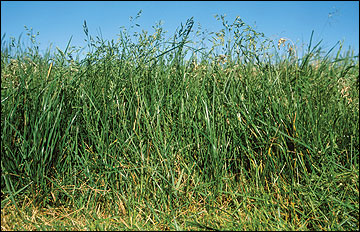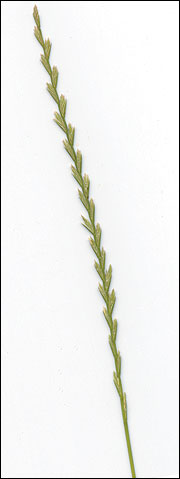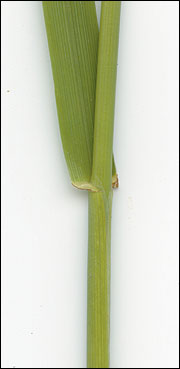Perennial ryegrass (Lolium perenne L.)
Cool-season grasses
Perennial ryegrass is routinely used for cattle and sheep pasture in Australia and New Zealand. In Missouri, it persists best in the southern part of the state. Under good management, it is a high-quality and high-yielding grass; forage yields of 10,000 lb/acre have been reported in southern Missouri. Like tall fescue, perennial ryegrass produces most of its yield during spring and autumn but lags behind other grasses in midsummer. Perennial ryegrass is aggressive under high rainfall and moderate temperatures and might crowd out other forage species under such conditions. It is not as tolerant of drought and temperature extremes as other cool-season grasses. Lack of persistence across the state has caused producers to avoid perennial ryegrass. Cultivars with improved plant persistence are currently being developed.
 Perennial ryegrass
Perennial ryegrass
 Yield distribution of perennial ryegrass in Missouri with deferred grazing.
Yield distribution of perennial ryegrass in Missouri with deferred grazing.
- Origin: Southern Europe
- Adaptation to Missouri: Best adapted to southern Missouri.
- Growth habit: Perennial bunchgrass.
- Blade: Folded in bud, keeled, ridged upper surface, smooth and glossy lower surface, margins slightly scabrous, tapered to tip.
- Sheath: Compressed to cylindrical, smooth, pale green, reddish at base, closed or split.
- Ligule: Thin, truncate to obtuse, membranous, rounded or toothed, about 1/15 inch long.
- Auricles: Small, clawlike.
- Seed head: Flat, awnless spikelets alternate edgewise up stem.
- Fertilization: 40 to 60 lb N/acre after the first grazing or harvest in spring, followed by another 40 lb N/acre after the second grazing if growing conditions permit. In addition, 40 to 60 lb N/acre should be applied in mid-August for fall pasture. Phosphorus and potassium to soil test.
- Timing of production: 60 percent of growth before June 15.
- When to begin grazing: When the grass reaches 6 to 8 inches in height.
- When to cut for hay: Early heading stage, typically in late April or early May.
- Lowest cutting or grazing height: 3 inches
- Fall management: Grazing possible in September and October if a 4-inch stubble is left for winter.

